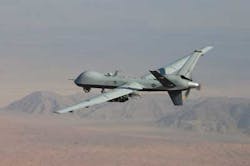Military seeks more capability from UAV vision systems
US Department of Defense (DoD) designers of unmanned aerial vehicles (UAVs) want more capability from their systems in terms of video processing, high-definition infrared imagery, storage, and image processing—and they want the processing to occur before it is downlinked. Ground control stations will be adding more capability as well.
Designers of control stations for unmanned vehicles primarily use commercial-off-the-shelf (COTS) embedded products, but there has never been a common architecture developed for all UAV ground control stations. Military planners are now pushing toward a common control segment architecture that requires all UAV control stations to work with one set of standards and hardware and software architecture to reduce costs.
The goal is to enable true autonomous missions in which the UAV is issued a mission plan and executes it while the ground control station essentially functions as a data collection depot. Eventually the ground control station will act like air traffic control because several UAVs will operate without one point of control. The different ground control stations will be networked together to handle collection of the data generated by several UAVs.
The Office of the Secretary of Defense (OSD) in the DoD has formed the Unmanned Control Systems, Control Segment working group to drive open standards in UAV ground stations. It will focus on UAV programs that are 20 lb or heavier.
More Vision Systems Issue Articles
Vision Systems Articles Archives
